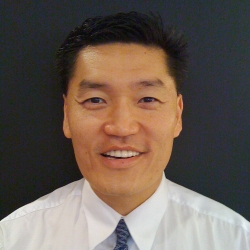
Harvey Hahn, MD, FACC
Journey to the Annual AMEN Conference, 2013
Since learning about AMEN several years ago, I’ve tried several times to make it to the annual meetings, but it has never worked out. Finally, after three years of trying—I made it, but barely. The day that we were to fly down to Orlando, as a family, my wife received a call and had to suddenly fly to South Korea! Thus, my sons and I went by ourselves.
When I first heard about AMEN, I had no idea what they (or now we) were about. Evangelism is something pastors do, and medical missionary work occurs in Africa, not during a routine blood pressure check in the United States. But after going to a couple of local meetings, I started to understand what they were talking about, even if I was still very uncomfortable about sharing my faith with patients. I graduated from Loma Linda University School of Medicine in 1994, and during my whole four years only four hours (one afternoon) was dedicated to the spiritual aspect of medicine. (I hear that has changed a lot since then.) Including medical school, internship, residency, and fellowship, I could count on one hand how many times I had talked to patients about spiritual issues or prayed with them. There was a massive, obvious disconnect between my purported faith and my medical practice.
One of my partners, AMEN member Dr. Brian Schwartz, kept talking to me, not just about joining AMEN but about melding my faith and my practice. Hesitant, I would give him all the typical excuses: I’m not comfortable. What if I get rejected? What if I offend someone? How is that going to help their care? I don’t have time for stuff like that. He tried to belay all of my concerns, but the best advice he gave me was: “Just try it and see what happens.” It’s very hard to argue against taking a trial run at something. He told me that, in his entire career, he’s been turned down less than five times.
That next week I decided to give it a try. I got rejected five times in that first week alone! I remember thinking: I knew this wasn’t going to work. I should leave this to the pastors! What kept me going was that, while I was getting rejected at a pretty high rate, the successes were really rewarding. Many patients told me that the prayer was the most important and best part of their visit. Some would then catch themselves and say, “Not that your medical care doesn’t help too.” They appreciated it so much and looked like they had so much peace – the same peace I feel when I pray – that I had to keep going.
The next week brought a brutal test to my faith in this newfound therapy. I had a string of rejections, including one patient that told me, “Doc, I trust you, so let’s not pray!” I remember asking God, “Please give me a bone throw, someone obvious and easy like a priest or a nun to ask to pray with.” The next patient I met after that prayer was a biker. Long hair, leather vest, lots of tattoos; he needed a cardiac cath for angina. I don’t know if I looked up towards Heaven, but I do remember saying in my mind, “Come on God!” At the end of our visit, after we had agreed that he should have a cath, I very timidly asked if he would like to pray together. His response shocked me. “That would be great, Doc!” So we prayed and everything went great during his cath and subsequent stenting procedure. I learned two important lessons that day. First, man sees outward appearances, God sees the heart; second, God has and awesome sense of humor.
Prayer has now become a routine part of my medical care. I also joined AMEN (i.e., paid my dues). After talking with others and reading, I started implementing some other faith sharing methods. I used to wear a Star Trek science/medical officer pin on my lab coat. It was a great conversation starter. People would always ask, “Is that a Star Trek pin?” Was that the conversation I really wanted to have with patients? I took off the Star Trek pin and started wearing a little cross instead. I don’t get as many comments as with the Star Trek pin, but the ones I do are a clear sign that I can share my faith openly with that patient.
I also started carrying literature in my lab coat pocket, in my car, and in all my offices. Kettering Medical Center produced a little book called “Trusting God in the Everyday,” based on Psalm 23. I like to give it out to patients who are really struggling. It also has a little tear out card in the back that can be mailed in and a Bible worker will follow up.
At this point I was running out of new ideas, so I made the decision to go to the AMEN meeting in Orlando hoping to learn more.
It was great to see old friends, catch up, and to learn how God was using them in their practices. It was also interesting to see how much food a basically skinny crowd could eat. My friend said that he overheard the staff saying that they had never seen such thin people eat so much food. What a great witness for our health message.
During the meeting there were multiple inspirational talks. I attended several breakout sessions on how to evangelize in your office. I also attended some health talks. In addition, there was a great session about the total patient experience and how we can help shape/write that story.
The best part of the conference for me was the sharing between members. You learn a lot from dialogue. One physician suggested that we pray over our patient list every morning. Not just praying for yourself to do a good job, but to pray for the health and healing of your patients. That one new thing has made a huge difference in my practice and my effectiveness already.
To be honest, when I looked at my patient list in the morning (and see particular names on the list) I typically prayed for myself. “Lord give me strength to get through this day.” Or ‘Why me? Why today did my nurse stack those two patients back to back? I thought she liked me.” Now, I pray for my patients on the list every morning, and it’s made a big difference in my attitude. People aren’t sick for my benefit or fitted around my convenience. My job is to try and help the sick get well. This one simple thing has completely changed my perspective.
Now when I look at my patient list, I see it as an opportunity to be involved with the greatest Healer the world has ever known. A long patient list no longer frustrates me, or even a list peppered with my more interesting patients. In fact, having a changed mindset has made me more open to their needs and better able to meet those needs. Those same patients that I used to dread seeing have been the most receptive to prayer with me. The difficult patients may not even realize that they are difficult, but only that doctors get frustrated with them, don’t listen to them, and eventually seem to stop caring for them. That’s not the type of evangelism I want to be a part of.
What did I learned from this years AMEN conference?
First, the most important lesson is simply the power of prayer. I’ve been more blessed by praying with my patients than I think that they have. When you pray, you call on God, and not on your own ability. That is hard to do sometimes, because we are all well-educated, intelligent, and independent people. But what does that mean before the Lord? I also learned the value of community. We need to reinforce each other, lift each other up, and learn from each other. We are not in this alone. Finally, with God on our side, who can really stand against us?
No question, I can say “Amen!” for AMEN.
<< | Table of Contents | >>
